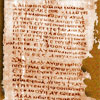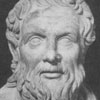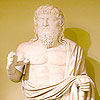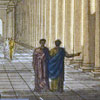Apollonius And The Book Of Revelations
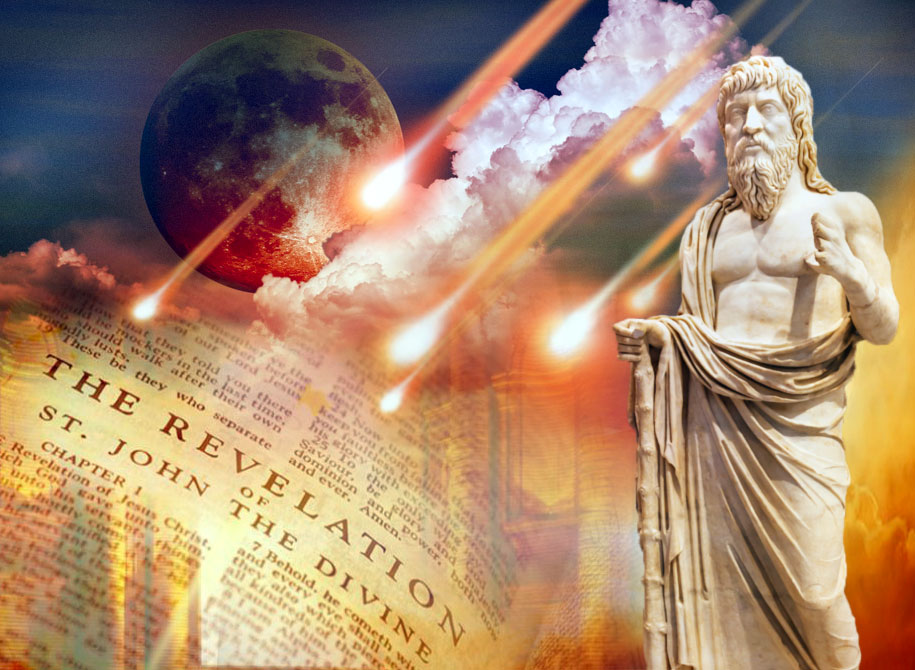 by Hilton Hotema
by Hilton Hotema
Last—Strangest—Oldest
Last book of the Bible
Oldest book of the Bible
Strangest book of the Bible
A book so strange that the best brains of the Christian world have never been able to interpret it.
A book so old that its origin is lost in the night of time.
A book so baffling that the church refused to let it become a part of the Bible until the 19th century; and then, for a most peculiar reason, it was embraced with open arms.
In the Bible this book is headed, “The Revelation of St, John the Divine.” It purports to be a revelation by God to Jesus Christ; Jesus Christ to his “angel,” and the “angel” to John, and John to the Seven Churches in Asia – and the churches rejected it as a fraud.
In referring to this book, Wm. McCarthy wrote: “The book is wholly a composition. Its material was taken from many sources, yet the compiler studiously refrains from indicating its source. In fact, he endeavors to make it appear the material was original with him” (Bible, Church and God, p. 691).
APOLLONIUS
The secret of this book and its source lie with that active man of the New Testament called Paul, whose real name was Apollonius. but his friends and followers called him Pol and Polos.
Apollonius was the greatest philosopher, mystic and magician of the first century, and he became the Mystery Man of the New Testament. When he visited India about 46 AD to study the Hindu religion and be initiated in the Indian Mysteries, he was given that Scroll which became the last book of the Bible.
What did he do with it? He brought it home with him, retired to the “Isle that is called Patmos” (Rev. 1:9), and there he translated the scroll into his native tongue, revising it to make it harmonize with the conditions of his country and the customs of his people.
Conclusive evidence to prove that all references to the gospel Jesus in “The Revelation of St. John the Divine” are fraudulent interpolations, inserted by the church fathers to deceive the faithful masses, appears in the fact that the Hindu Masters produced the Scroll thousands of years before the world ever heard of that Jesus.
When Pol made his first copy of the Hindu Scroll he titled it “Initiation of Anointed Ieosus.”
When the Greeks copied Pol’s copy, they changed the title to “Apocalypse.”
When the Greek copy was translated to English, the title was changed to “The Revelation,” and “St. John The Divine” was presented as the author.
What was the original title of the Scroll?
When Pol copied the Scroll, his work shows he was not free of egotism. He studiously refrained from indicating its source, and carefully endeavored to make it appear the material was original with him, wrote McCarthy.
Pol inserted many changes in the context of the Scroll to disguise its true origin and make it appear as his own work. But he “let the cat out of the bag” when he had to go into the field of the Kundalini Power of the Hindus by including the BOOK WITH SEVEN SEALS (Rev. 5).
The Book with Seven Seals is definite, positive and conclusive evidence to prove the source of the Scroll. For most of the ancient Hindu scriptures revolve around the Seven Chakra of the Human Body.
It is conceded generally that the scriptures of the Brahmins are anterior to the oldest part of the Bible. The Vedas, Puranas, Upanishads, etc., are filled with fables relating to the body with its Seven Chakras, its organs, glands, and functions.
THE HINDU SCROLL
What happened to Pol’s copy of the Hindu Scroll after his death about 98 AD? It was found by one Marcion at Ephesus, along with some of Pol’s other writings, some of which were used by the clever Bible makers in compiling the New Testament. But they rejected this scroll, largely because its symbols and parables could not be comprehended.
REINCARNATION
The church authorities rejected the scroll as fraudulent. Luther doubted the scroll’s inspiration. Erasmus and Swingli both rejected it. Calvin doubted it?
How was this opposition overcome, and the scroll, regarded as a fraud for sixteen hundred years, finally adopted by the church and included in the Bible?
A clever priest took charge of the rejected scroll. He studied it, and he saw in it things which would greatly redound to the benefit of the church, if properly presented. That was something always welcomed by the church.
The Ancient Masters taught the Doctrine of Reincarnation. In fact, it was such common knowledge in those days that it was always treated as esoteric in all archaic religions and philosophies. Knowledge of its truth, on a basis of personal experience, was one of the first results obtained by him who entered upon the initial stages of the telestic work.
Whether the doctrine is true or false is beside the point here, as we are following the ancient teachings.
Reincarnation played a leading role in this Hindu scroll. It was that return of Solar Man to a future incarnation which made the clever priest see what he saw.
He saw that he could produce a translation of the scroll, have it appear as “The Revelation of Jesus Christ, which God gave unto him” (Rev. 1:1) and then by a little more twisting and distorting, make the return of Solar Man to a future incarnation appear as THE SECOND COMING OF CHRIST.
The first millennium had come and gone and the Christ so diligently expected had failed to appear. So now the time was ripe to prepare the mind of the gullible masses for the “Second Coming” at the end of the next millennium. Why not? That would hold them in line a little longer.
So the cunning priest made his translation say: “For the time is at hand.” “Behold, he (Christ) cometh with clouds; and every eye shall see him, and they also which pierced him; and all kindreds of the earth shall wail because of him” (Rev. 1:3, 7).
Then he went all out in the 20th chapter and made it amazing by itself:
“And I saw thrones, and they sat upon them, and judgment was given unto them; and I saw the souls of them that were beheaded for the witness of Jesus, and, for the word of God, and which had not worshiped the beast, neither his image, neither had received his mark upon their foreheads, or in their hands; and they lived and reigned with Christ a thousand years” (Rev. 20:4).
When this revised and perfected translation was placed before the church authorities in the 19th century, it was quickly accepted with open arms; and that is how –
The strangest book of the Bible;
The oldest book of the Bible,
Came to be
The last book of the Bible.
And this Hindu scroll, less than two centuries ago, was made the last book of the Bible; for it had to come after the New Testament so the gospel Jesus could be made the Hero of it.
Then with the ancient writings destroyed, the church never suspected that anyone, clergyman or layman, would ever be able to interpret the strange symbols and allegories of the scroll.
MARCION
The man Mark of the second gospel of the Bible is termed by history the Father of Christianity. It would be more correct to term him the Father of the New Testament, translated by him from the writings of Apollonius.
This man was one Marcion, a native of Cappadocia, a small country in Asia Minor, adjoined on the side by the smaller country of Calicia. Which borders on the Mediterranean Sea and touches the Gulf of Issus, on which gulf is the city of Tarsus, home of Saul, later called Paul, who said:
“I am a Jew of Tarsus, a city of Cilicia, … yet brought up in this city (Jerusalem) at the feet of Gamaliel, and taught according to the perfect manner of the law of the fathers” (Acts 7:58; 21:39; 22:3).
Marcion was an educated and influential Cappadocian, and spoke the Samaritan language, the same as Apollonius.
Like all men, he was looking for fame and fortune. He had heard of the great work of Apollonius, and about thirty years after the latter’s death, he went to Ephesus and Antioch and collected what he could find of the writings of Apollonius, among which was the Hindu scroll.
These writings were in the Samaritan tongue, and were not available to the Greek and Latin scholars of the time.
Pol (Apollonius) was the Father of Christianity, as it was he who produced the writings that became the New Testament. But it was Marcion who translated them into Greek, and began the work that laid the foundation of the New Testament that is the reason why he is called the Father of Christianity.
As Marcion worked on these writings, he discovered that they contained secrets of Life not known by the world at large. He saw that this fact presented a rare opportunity to make him great, and he grabbed it. That was about 130 AD.
Charles B. Waite, a fearless and tireless searcher for truth, showed beyond all question in his “History of Christianity to 200 AD” that the gospel of Marcion was the original work from which the four New Testament gospels were later fabricated by the biblical plagiarists. He demonstrated that the author of the Mark and Luke gospels and the Pauline Epistles were one and the same person.
According to Marcion, the real foundation of the Pauline Epistles, as he copied and translated them, “was the sign of the Zodiac known as Aries, the Ram or Lamb. The early Christians all worshiped a lamb instead of a man on a cross” (Ant. Unv. p. 154).
This statement is supported by the further fact that at the Sixth Ecumenical Council held at Constantinople in the year 680 AD, it was ordained and decreed “that in place of a lamb, the figure of a man should be portrayed on the Cross” (Ant. Unv. p. 161).
When Marcion translated the Hindu scroll into Greek, he found its symbols and allegories too deep for him to fathom, so he lay it aside as useless to him.
But it was fortunate for the seekers of truth that the Greek translation of the scroll preserved its true and correct contents, and shows how greatly the clever priest distorted the scroll in order to make it acceptable to the church authorities as part of the Bible.
APOCALYPSE
In the old Greek translation the title of the scroll was simply “Apocalypse,” a Greek word meaning to reveal, to disclose, to disrobe, to unveil, and that was the reason why the clever priest translated the title “Revelation” – yet to the clergy it reveals no more than it did to Marcion; and Isis wrapped in her peplum was never more safe from the eyes of the world than is the inner meaning of the Apocalypse.
Fundamentally, the Apocalypse is a fable. It is one of the most stupendous fables ever written. So comprehensive, complete and coherent is the fable, that its full beauty, even its fine finish of details, can be perceived only when viewed in its entirety.
Nor can its esoteric meaning be grasped by mere analytical study. Its multiplicity of details and reduplication of symbols have esotericists utterly faring worse through their inability to distinguish from the main action of the fable and the explanatory matter introduced as side-scenes.
The Hero of the fable is Solar Man; and the context of the fable describes the conquest of Physical Man by Solarical Man.
The description of the struggle is fabulized in terms of cosmic phenomena because it relates to cosmic production and treats of cosmic processes. The substance of the description lies beyond the understanding of all who are not well-versed in the secrets of occultism and the details of metaphysics.
The details of the fable, present in symbol and parable, the sensations and emotions which are experienced by Solar Man as he tremblingly goes through the various ordeals of the solemn ceremony of Initiation in the Higher Life, are taught in the Sacred Ancient Mysteries.
It is similar to an attempt to describe the sensations and emotions of a candidate who goes through the various ordeals of the ceremony of Initiation in the Masonic Lodge and do it in symbol and parable.
What relation would that have to Christianity? to religion? to theology? or to heaven? Yet that is exactly what and all the Apocalypse is – a description by the Ancient Masters in symbol and parable, of the strange sensations and emotions experienced by the neophyte as his mind and body react and respond to the strange things he encounters in the various tests to which he is subjected in the ordeals of initiation in the Ancient Mysteries.
That is the reason why Pol titled his copy of the scroll “Initiation of Anointed Ieosus.” For that is the correct title.
And furthermore, these psychic emotions and physical sensations are skillfully presented in terms of cosmic phenomena – as the flashing glare of lightning, the crashing roll of thunder, the quivering shock of the earthquake, and the ceaseless murmur of the waters.
THE ANCIENT WISDOM
We move into the very midst of the Mystery of Man as we approach the borderline of the Living World, so cleverly portrayed in symbol and parable in the Hindu Scroll.
As the great Carrel clearly showed the world in his remarkable book, “Man The Unknown” that modern doctors do not possess the psycho-bio-physiological knowledge of man that is necessary for a survey of the Apocalypse, we are certain that the laymen does not.
Therefore, a brief sketch, in simple terms, will be given of the topics that must be considered and reviewed in the interpretation of this Hindu Scroll.
First, the point where the ancient arcane system sharply diverges from all conventional schools of thought, is in the means of acquiring knowledge.
Conventional scientist and orthodox religionists rely for knowledge on the physical senses, psychic emotions, and intellectual faculties as they are in the present state of human development and human degeneration.
Tho scientist enlarges the scope of the senses by the use of microscope, telescope, and other mechanical devices, but these can never reach beyond the material.
The religionist puts his faith in ancient scriptures which have been distorted by the church, and which are misleading to the esoteric because they were not written to be understood by anyone but the initiates. That is the reason why this Hindu Scroll cannot be interpreted by the clergy.
The esotericist refuses to be confined within the narrow limits of the five senses and the mental faculties. He realizes that the gnostic powers of Solar Man are hopelessly obstructed by the imperfect instrument, the physical organism, the material garment in which he is clad and through which he must function; so he devotes himself to what may be termed intensive self-evolution, the conquest and utilization of all the forces and faculties that lie latent in that fontal essence within his own body, which is the primary source of all the elements and powers of his Being, of all that he is, has been, and will be. THAT MYSTERIOUS KINGDOM WITHIN.
By raising his state of consciousness, and by gaining conscious control of the concealed potentiates that are the proximate cause of his individual evolution, the esotericist seeks to tread the path that leads to solar illumination and spiritual liberation from physical bondage, moving forward, as it were, toward that goal which mankind, as a whole, will never reach, because great skill, knowledge and perseverance are required to aid the Seeker of Light in avoiding the snares and traps placed along the path by tyrants and their henchmen.
The difficult task of the Seeker of Light is not so much to know as to become. To know is easier than to become. Many know, but lack the willpower to become.
Herein lies the powerful import of the Delphic inscription, “Know Thy Self,” and the ancient admonition, “He that overcometh the desires and passions of the flesh, and obeyeth the command not to eat of the ‘forbidden fruit,’ the same shall inherit all things good in life; and I (Perfection) will be his Guide, and he shall be my son” (Gen. 2:17: Rev. 21:7).
Regardless of the profundity of our knowledge, if not intelligently and persistently applied, it is worthless.
The esotericist understands that true self-knowledge can be attained only thorough self-development and self-conquest in the highest sense of the terms – a development that begins with the conquest of pernicious habits and leads on to a healthy body and an introspection and the awakening of the regenerative forces which slumber in civilized man’s inner protoplasmic nature, like the vivific potency in the female ovum, which, when activated, transforms man into a divine being.
This course of transcendental self-conquest, the development of man from the concealed essence of his own embryonic nature of a self-luminous, immortal being, is the sole subject matter of the Hindu scroll, which contains, in symbol and parable, an almost complete outline of the psycho-bio-physiological process of Redemption.
If the misled clergy knew aught of man’s psycho-bio-physiological constitution, they would never attempt to interpret the Apocalypse as treating of “heaven and the church.”
Excerpt from Son of Perfection
Posted in Other Topics, True History of Manwith comments disabled.


